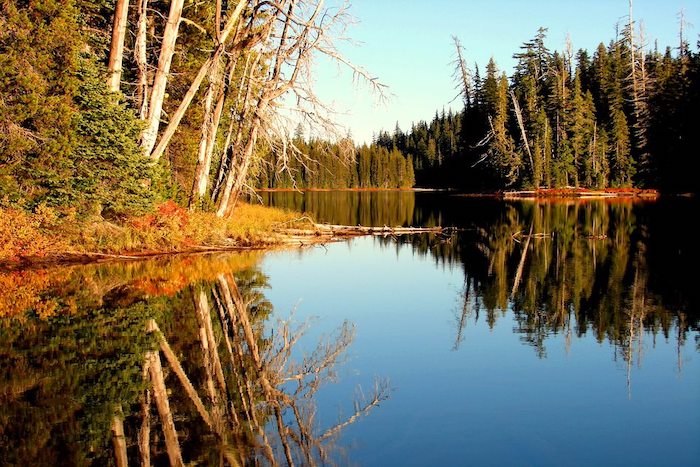
Sacred-Earth Land-Nurturing, a book by Steven D Redman, has been compiled for farmers, homesteaders, land-carers, environmental educators, conservationists and more. It amalgamates the theories and ethics of Permaculture, Land Stewardship and Biodiversity Conservation practices, plus it provides useful templates to help assist with nurturing of the planet.
Each week on Permaculture News we will share with you a snippet from various chapters of the book which is available on Blurb
Todays snippet is an extract from Chapter 3 – Nurturing Ecological Sublimity
I think that every town should have a park, or rather a primitive forest, of five hundred or a thousand acres, either in one body or several, where a stick would never be cut for fuel, not for the navy, not to make wagons, but stand and decay for higher uses—a common possession for instruction and recreation.
-Henry David Thoreau, 1859.
The vital work of restoring the watershed has been recognised. We are free in our life journeys to pursue creative work. Our flow is liberated for the synthesis of new and honourable life ways of ecological nurturing. Caring for the Earth is caring for children, families, community, country and world. We are here today because people of the past did not ruin everything. We must continue that legacy of promoting responsible relationships within the watershed communities.
This would be an appropriate place to consider the philosophy of ecological stewardship. I want to save most of that discussion for chapter six, however. Here, I prefer to examine the origins and instances of ecologically-sensitive practices.

The Earth and its wilderness are the primary model with a billion-year record of proven stewardship. Just consider what it did after the big asteroid strike 66 million years-ago. Life just found a new course, and created yet another bewildering miracle! The Earth’s examples were passed on to tribal people and honored for hundreds of thousands of years. Nowadays, we can also find guidance in the contributions of eminent scientists and Earth-keepers. In addition to these bio-neering people, there are many cases of good and creative practices being implemented today. These provide great inspiration to our journey. I will also share how I practice ecologically-sensitive land stewardship in a young, pine forest in Michigan. The larger goal is to inspire your plans and actions, and to encourage you to become a land-nurturer on your land and in your community.
The actual truth of this Living Planet in this solar system gives us not only Life itself, but all the gifts we enjoy in each of our lives. Why would we not care for this Living system? It has a proven, reliable and vital record of sacred care. The ultimate case of Life-honoring care is the wild Earth. “In wildness is the preservation of the world.”, Thoreau said. We enter a vast, pristine, wild area and we can’t help but feel its sacred thoughts in our bones and sparkling through our aroused and awake body-mind-spirit.
Restoring damaged wild areas is a sensitive act of nurturing. And, keep in mind, that all areas were once wild, and that deep in the Earth and in outer space, it most certainly is one hundred percent wild. But, in terms of land conservation and domestic relationships with the land, the ecotone is of great interest.
As I understand it, an ecotone is a meeting place or convergence point in an environment. All manner of variation may occur in such places throughout the world, but the basic idea, is that, two ecological communities meet at a certain place: a hill and a plain, a forest and a lake, or an alpine habitat meeting the subalpine at a certain elevation on a mountain. Two or more ecosystems mingle there. The result might be an abrupt transition, an intermingling, or even a third community very different from the other two. One could even think of examples where five ecosystem types occur in close linear proximity. Imagine a deciduous, oak forest coming down a hill to a stream. On one side of the stream a birch-aspen-hemlock swamp forest borders the hilly, oak wood. Then, there is the stream habitat itself, but on the other bank it is very rocky, and a cedar and serviceberry wood grows there. Continuing along the transect, we observe that the cedar wood gives way to a pine and red maple forest.
The concept of a micro-habitat is less studied than that of the ecotone, but it is no less important to land nurturing. Imagine that we now walk perpendicular to the transect described above. We are between the oak woods and the swampy, birch groves. But the stream bends and comes to a large rock outcrop on this side of the stream, near our path, and there is a sizable log-jam there by the rock, and a little sandy beach exists there by the log-jam. In the stream near the beach, a safe pool-perfect for swimming in—has formed. Not only that, but the previously distinct habitats seem to have joined here. The back side of the great rock has swampy soil and birch, white oak and hornbeam grow there. Cedar, serviceberry and huckleberry grow right upon the rock, but the beach is shaded by a huge white pine, and under it grow striped maple. There is also a flat, perfect spot to set up a wilderness camp up in the oak about a hundred feet from this special place. What we have found is a sacred micro-habitat—a place so unique that we know immediately to tread lightly and treat it with great care. In these magical, wild places, Earth has provided exquisite models to inspire the nurturing of domestic lands.












